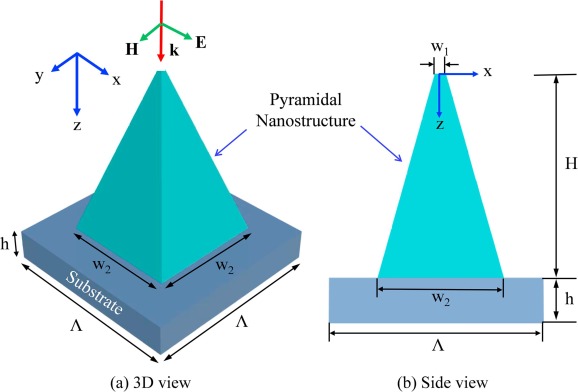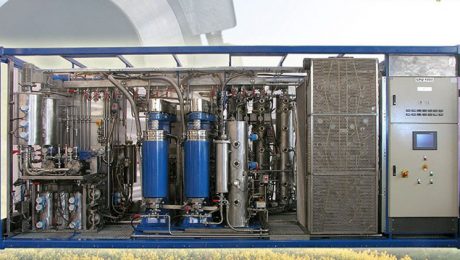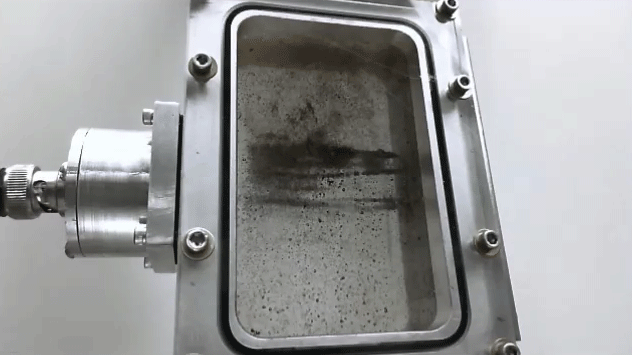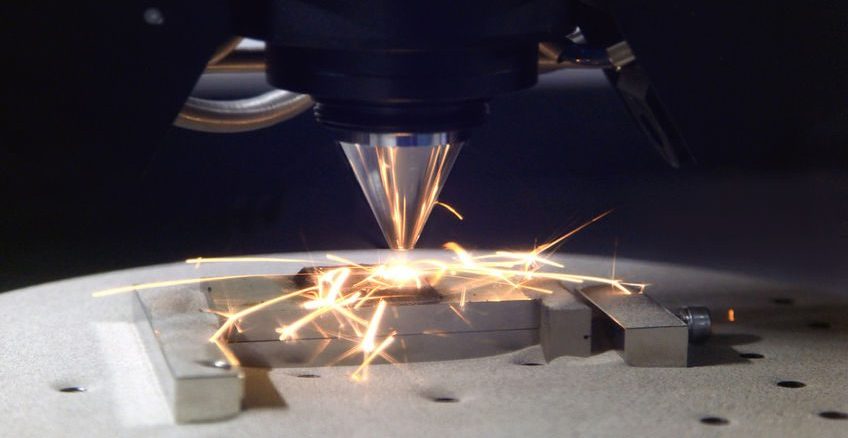SHARE
6 Mechanical Engineering Innovations that could Change the Industrial Game
6 Amazing Mechanical Engineering Innovations that could be Industry Game-changers
Take a look at some of the latest mechanical engineering innovations that aim to make our lives easier.
If you are interested in recent engineering challenges, learn more about them in our recent challenges section. You can visit our open innovation page where we show examples of engineering innovation solved by our community.
1. An absorber design using a natural hyperbolic material for harvesting solar energy
Researchers led by Professor Ping Cheng, from Shanghai Jiao Tong University, in collaboration with Professor Zhuomin M. Zhang, from Georgia Institute of Technology, developed a perfect light absorption structure that utilizes an array of pyramidal nanostructures made of bismuth telluride (a natural hyperbolic material) over a thin substrate to absorb incident solar radiation.

The study successfully presented a perfect absorber design that manipulates a periodic array of pyramidal nanostructures that are made of a natural hyperbolic material bismuth telluride on a metallic substrate. The results from the experimental procedure undertaken in this study have shown that the proposed structure can achieve absorptance values of almost 100% in the wavelength range of 300–2400 nm, upon which most of the solar radiation spectrum fall into. Altogether, the proposed metamaterial has great potential application and can lead to the effective harvesting of solar energy during photothermal conversion processes in water or aqueous solutions.
2. Windows Double as Solar Panels: fully transparent solar-power-generating windows
These windows are a great example of mechanical engineering innovations. They have solar cells installed in the edges at a specific angle, which allows the incoming solar light to be efficiently transformed into electricity. The windows could generate 8 to 10 watts of power, according to Grapperhaus."Right now, we are looking for iconic projects all over the world to show that a large glass building can be made energy neutral in an aesthetic way."

Photographer: Jasper Juinen
3. Experimental investigation on the performance of non-metallic flexible fire-resistance materials in flameproof diesel engine locomotive
Three kinds of flexible refractory fiber materials were used to verify the performance of fire resistance, according to explosion-proof principle and test methods of flame arrests. Then, a comparison of transmission efficiency between flexible refractory fiber arresters and general arresters was given. The aim of this is to verify the properties of non-metallic flexible fiber materials in fire resistance and transmission efficiency so that we can apply it to the flameproof diesel engine locomotive.

Theoretically, refractory fibers have good performances of air permeability and complex internal space, so it can provide with absorption area. First, irregular porous structure increases the cooling area. The temperature of the flame can decrease under the ignition point and quench after the heat exchange. Tiny pores of the porous materials, moreover, increases the probability of absorbing free radicals during chain reaction so as to prevent the combination of free radicals and premixed gas. Then, the chain reaction will slow down and even terminate.
The investigation was aimed at testing the performances in fire-resistance and transmission efficiency of non-metallic flexible materials in flameproof diesel engine locomotive which may replace traditional metal flame arresters with low gas transmission efficiency. On the basis of the chain reaction mechanism, the mixed gas was burnt in the experiment, and the free radical which can be absorbed by tiny pores of flexible fiber materials and quenched was released (1School of Mechanical and Electrical Engineering, China University of Mining and Technology, Xuzhou, China2Jiangsu Collaborative Innovation Center of Intelligent Mining Equipment, Xuzhou, China-Kedi Chen, Baolin Li).
4. Biodiesel Production from Waste Cooking Oil by Using an Ultrasonic Tubular Reactor
The aim of this research is to find an optimum synthesis biodiesel from waste cooking oil (WCO) using an ultrasonic tubular reactor. The experimental studies explored the variations in:
- reaction time
- molar ratio WCO to methanol (MeOH)
- amount of catalyst
- the frequency of ultrasonic and output power ultrasonic on the ester contents.
Comparisons of type ultrasonic and also the mechanical stirring method based on time reaction were investigated.

The optimum results of the biodiesel process is the reaction time of 5 minute, NaOH catalyst 1%wt of WCO, molar ratio WCO to MeOH of 1:6, frequency ultrasonic of 20 kHz and output power ultrasonic of 650 W. The reaction time reduced 12-24 times compared to both of method and the yield of ester contents was obtained at 96.54%wt.
5. Acoustic Wave Separation
FloDesign Sonics, with funding from the National Science Foundation, has developed mechanical engineering innovations with uniquely effective patented technology called Acoustic Wave Separation (AWS) that separates or cleans water or other liquids from other contaminants. Acoustic waves were the secret behind this breakthrough technology that divorced all foreign substances such as radioactive material, hydrocarbons, bacteria, chemical additives, salt, and more, without the use of chemicals or filters.

Their immediate goal was to be able to process 100,000 gallons a day for the gas and oil industry. This same technology could also be used to cleanse blood during surgery, to reclaim proteins from the cells of mammals, as well as many uses in gene and cell therapies. This groundbreaking AWS technology will have innumerable potential uses in the future (https://www.nsf.gov/water).
6. Hybrid simulation of thunderstorm outflows and wind excited response of structures
Structural components such as buildings, bridges, and tunnels are often affected by actions of winds and thunderstorms outflows. The need to control their effects on structures has resulted in numerous researchers in the wind engineering field. The study by Professor Giovanni Solari and his team will help in gathering different data involving such structures which will thus be analyzed to produce robust results that may be further used in understanding other effects such as those resulting from aerodynamic damping.
The authors successfully investigated wind-excited responses through modal analysis and time-domain approaches. In the simulation analysis, some parameters such as aerodynamic damping and transient aerodynamic effects were neglected. The obtained results also helped in getting the information about classic analysis. This was done about synoptic stationary cyclones. It was however observed that thunderstorms outflows often induce a major structural response as compared to synoptic stationary cyclones.[gallery columns="2" ids="15421,15423"]
However, both synoptic and thunderstorms events experience similar qualitative responses as far as the dynamic response and wind loading on the structures are concerned. The same similarities for the two cases are too witnessed with the aerodynamic admittance.
Hungry for more mechanical engineering innovations and challenges?
The ennomotive community of engineers has already solved the following:
New window-cleaning system in tall buildings
Cleaning windows in high-rise buildings is a complex task. To carry it out, cleaning workers are usually hired, as the devices on the market that can do this task automatically are not yet good enough. This challenge sought a new system for cleaning windows in high-rise buildings that would be safer, more efficient and more sophisticated than the current ones.
Designing a New modular and transportable factory
Have you ever heard of temporary factories? Open innovation led to a better building solution that can shorten assembly and disassembly time and cost, along with transportation from one to another worksite making temporary factories more viable and flexible.
Preventing sand accumulation on railways across the desert
High speed rail is becoming more popular and is expanding into many countries, which brings new challenges, such as crossing deserts. The biggest challenge was to come up with a way to get rid of the sand covering the tracks. Therefore, an innovative solution was found to minimize, maintain and clean up the sand covering the railway tracks.
Redefining the installation of tramway rails
A creative solution was given to reduce noise and improve the replacement of tramway rails by using new materials and installation procedures. This helped accelerate the installation of new tramway rails and solve the inconvenience of traditional embedded grooved rails.
Read more about these projects and participate in future ennomotive engineering challenges.
You can also check out our blog for more articles about mechanical engineering innovations, don´t miss out!
